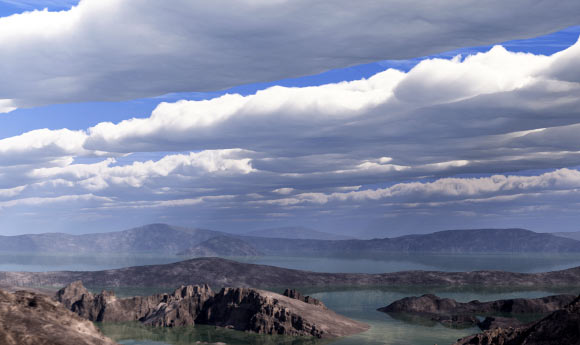当前位置: Language Tips> 双语新闻
What Mars Looked Like 4 Billion Years Ago

|
A new animation by NASA scientists illustrates what Mars – the fourth planet from the Sun and the second smallest planet in the Solar System – may have looked like billions of years ago. Today, Mars is a cold, desert world. Liquid water cannot exist pervasively on its surface due to the low atmospheric pressure and surface temperature, although there is evidence for spurts of liquid flow that perhaps consist of a briny solution with reduced freezing temperature. Water under current conditions can be ice or sublimate directly into vapor without staying in a liquid phase. Around 4 billions of years ago when the planet was young, it appears to have had a thick atmosphere that was warm enough to support oceans of liquid water – a critical ingredient for life. The animation shows how the surface of the Red Planet might have appeared during this ancient clement period, beginning with a flyover of a lake. “There are characteristic dendritic structured channels that, like on Earth, are consistent with surface erosion by water flows. The interiors of some impact craters have basins suggesting crater lakes, with many showing connecting channels consistent with water flows into and out of the crater,” explained Dr Joseph Grebowsky from NASA’s Goddard Space Flight Center in Greenbelt, who is the project scientist for NASA’s Mars Atmosphere and Volatile Evolution (MAVEN) mission. “Small impact craters have been removed with time and larger craters show signs of erosion by water before 3.7 billion years ago. And sedimentary layering is seen on valley walls. Minerals are present on the surface that can only be produced in the presence of liquid water.” Estimates of the amount of water needed to explain these features have been made that equated to possibly as much as a planet-wide layer 1,640 feet deep or more. If liquid surface water existed in the past, then Mars’ atmosphere had to have had a different climate that was warmer and a pressure near or greater than the current terrestrial atmospheric pressure at the surface. In the animation, rapidly moving clouds are employed to suggest the passage of time, and the shift from a warm and wet to a cold and dry climate is shown as the video progresses. The lakes dry up and freeze over, while the atmosphere gradually transitions from Earthlike blue skies to the dusty pink and tan hues seen on Mars today. It’s unknown if the habitable climate lasted long enough for life to emerge on Mars. “The only direct evidence for life early in the history of a planet’s evolution is that on Earth,” Dr Grebowsky said. “The earliest evidence for terrestrial life is the organic chemical structure of a rock found on the surface in Greenland. The surface was thought to be from an ancient sea floor sediment. The age of the rock was estimated to be 3.8 billion years, 700 million years from the Earth’s creation. No fossil evidence of life has yet been found from this period. The oldest claimed micro-fossils date to 3.5 billion years ago. The existence of a potential life-nurturing climate on Mars ended near these times. A comparison between the two planet’s life histories must be done with caution, due to the different chemical compositions of the surfaces and different volcanic and meteoroid impact histories. Also, the histories of life on either planet may not have been continuous. Catastrophic events could have killed off all life at one time only to have it start anew.” The animation ends with an illustration of NASA’s MAVEN mission in orbit around present-day Mars. MAVEN will investigate how Mars lost its atmosphere. Scheduled to be launched in November, it will arrive at Mars in September 2014. |
据sci-news网站11月18日报道, 今天的火星是寒冷荒芜的世界。由于气压和表面温度低,液态水根本无法存在,不是变成冰,就是直接升华为蒸气。不过,40亿年前的火星可不是这样。那时它还很年轻,有着厚厚的大气层,这让火星温度适宜,水也能够存在,而水是生命的象征。 美国航空航天局(NASA)科学家日前发布了一个新动画短片,推演了火星40亿年前的模样。动画向人们展示了蓝天、白云和清澈的湖水,这似乎是地球上某处风景秀丽之地。但你绝对很难想象,这很可能就是40亿年前的火星。 NASA"火星大气和挥发性演化"(MAVEN)探测器项目科学家约瑟夫·格雷布斯基说:“火星表面有分布着许多树枝状的水道,就像地球上一样,这是水流冲刷的结果。” 而如果火星表面过去存在液态水,那么火星的大气层必须能营造更温暖的气候环境,还需要有一个与目前地球表面大气压相当或者更大的气压。 动画中迅速移动的云表示时间的斗转星移,此外,动画还演示了火星由温湿的宜居天堂变为干冷的红色星球的过程。 目前尚不清楚火星上的宜居气候有多长,能否孕育生命。 格雷布斯基说:“在星球演变历史早期,有直接证据证明生命存在的星球只有地球。” “地下生物的最早证据是在格陵兰岛地表发现的有机化学结构的岩石,被认为来自古代的海底沉积物。该岩石的年龄估计有38亿年,此时地球诞生已有7亿年。不过,这个时期并没有发现生命的化石证据。最古老的微生物化石还需追溯到35亿年前。比较地球和火星的生命历史必须很谨慎,因为各自地表化学成分、火山岩和天体冲击影响都不一样。同时,两个星球上的生命历史都可能不连续,灾变事件可能一次性杀死所有生物,然后重新开启生命历程。” 动画的最后显示MAVEN探测器正在目前火星的轨道上运行,该探测器于11月18日发射,明年9月抵达火星,任务是探究火星的大气层是如何逐渐消失的。 相关阅读 (译者 闻竹 编辑 王辉) |
上一篇 : 致命时刻:肯尼迪遇刺现场特工的回忆
下一篇 : 孩提时期的音乐训练可提高脑力
电话:8610-84883645
传真:8610-84883500
Email: languagetips@chinadaily.com.cn